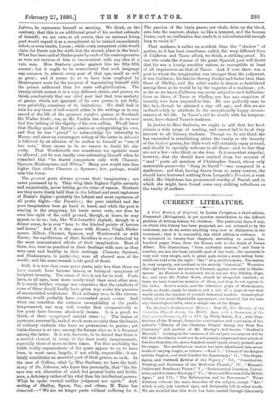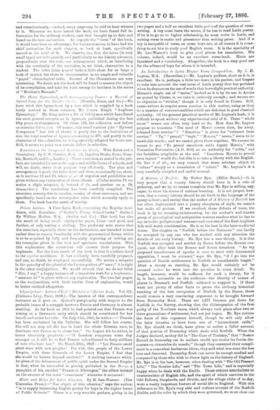The Student's Ecclesiastical History : Part IL, The History of
the Christian Church daring the Middle Ages, with a Summary of the Reformation Centuries, XL to XVI., by Philip Smith, BA, with Illus-
Centuries," and another of Mr. Murray's well-known "Student's Manuals." Looking at the vastness of the subject, no surprise will be felt that the history could not be adequatelycompressed into a book of less size than this, viz., seven hundred small-typed, closely printed, post Svo pages. The multifarious matter has been distributed into seven books of varying length, as follows :—Book I., " Climax of the Empire and the Papacy, and their Conflict for Supremacy;" II , "The Degra- dation and Outward Revival of the Papacy ;" III., "Constitution, Worship, and Doctrines of the Medimval Church ;" IV., "Monastic Orders and Mendicant Friars ;" V., "Ecclesiastical Learning, Univer- sities, and Scholastic Theology ;" VI., "Sects and Heresies of the Middle Ages;" and VII., "The Reformation and its Precursors." These divisions exhaust the main branches of the subject, except "Art," which is only just touched upon, and designedly left to other hands. We are satisfied that this work has been carried through laboriously
and conscientiously,—indeed, every page may be said to bear witness to it. Wherever we have tested the book, we have found fall in- formation for the ordinary student, and that brought up to date and based on the best authorities. As regards the "form" of the book, it would have been an advantage, for various reasons, to have had the chief authorities for each chapter, or book at least, specifically named at the head of it. We observe, too, that the notes (in very mall type) not infrequently, and particularly as the history advances, preponderate over the text,—an arrangement which, as interfering with the continuity of the narrative, is, we think, obstructive to a student. The index (nine pages) looks a little short for so large a body of matter, but there is compensation in an ample and valuable "paged" chronological table. Several of the illustrations are very interesting. We doubt not the book will be found to answer the object of its compilation, and take its rank among its brethren in the series of "Student's Manuals."



































 Previous page
Previous page